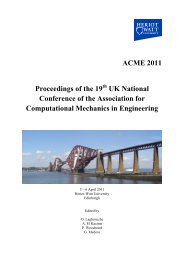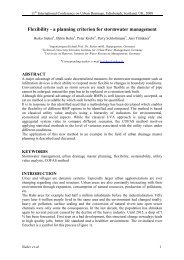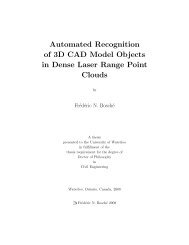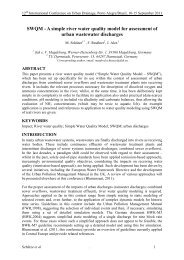ADESBA - A new general global control system applied to the ...
ADESBA - A new general global control system applied to the ...
ADESBA - A new general global control system applied to the ...
You also want an ePaper? Increase the reach of your titles
YUMPU automatically turns print PDFs into web optimized ePapers that Google loves.
12 th International Conference on Urban Drainage, Por<strong>to</strong> Alegre/Brazil, 11-16 September 2011<br />
The vast majority of RTC <strong>control</strong> algorithms <strong>applied</strong> in practice are individual solutions<br />
which cannot be transferred <strong>to</strong> o<strong>the</strong>r sewer <strong>system</strong>s. The PASST program (RTC planning aid)<br />
of <strong>the</strong> DWA (German Association for Water, Wastewater and Waste) (DWA, 2005) helps<br />
network opera<strong>to</strong>rs <strong>to</strong> carry out a simple assessment and evaluation of <strong>the</strong> potential for RTC in<br />
<strong>the</strong>ir drainage <strong>system</strong>s. But so far no <strong>to</strong>ol for <strong>the</strong> simplified creation, realisation and implementation<br />
of an RTC <strong>system</strong> has been available on <strong>the</strong> market.<br />
This is where <strong>the</strong> <strong>ADESBA</strong> project came in. The objective of this project, which is funded by<br />
<strong>the</strong> German Federal Ministry of Economics and Technology, was <strong>to</strong> facilitate <strong>the</strong> implementation<br />
of a pre-assembled <strong>control</strong> algorithm within a physically pre-assembled <strong>control</strong> box in<br />
order <strong>to</strong> simplify <strong>the</strong> implementation of RTC <strong>system</strong>s, making it faster and more easily manageable.<br />
The <strong>general</strong> <strong>control</strong> algorithm has been developed at ifak Magdeburg, a non-profit institute<br />
for <strong>applied</strong> research. The algorithm has been implemented in standard process <strong>control</strong>lers and<br />
<strong>the</strong> hardware subsequently tested by SEGNO au<strong>to</strong>mation company in Bremen. The Institute<br />
of Sanitary Engineering of Leibniz University of Hannover (ISAH) has confirmed <strong>the</strong> validity<br />
of <strong>the</strong> algorithm by additional simulation studies and has implemented this type of real-time<br />
<strong>control</strong> <strong>system</strong> in<strong>to</strong> practice in <strong>the</strong> city of Hildesheim in cooperation with Segno (see Pabst et<br />
al., 2010).<br />
CONTROL SYSTEM DESIGN AND CONTROL ALGORITHM<br />
The <strong>general</strong>-purpose <strong>control</strong> algorithm developed at ifak is <strong>the</strong> essential, key step in <strong>the</strong><br />
development of <strong>the</strong> <strong>ADESBA</strong> RTC <strong>system</strong> box and is described in greater detail by Alex et<br />
al., 2008 and Schütze et al., 2005. The development and implementation of this <strong>general</strong>purpose<br />
<strong>control</strong> <strong>system</strong> algorithm makes possible a pre-assembled, configurable <strong>control</strong><br />
<strong>system</strong> based on a small number of securely pre-defined input parameters.<br />
The basic idea behind <strong>the</strong> <strong>ADESBA</strong> <strong>control</strong> <strong>system</strong> is <strong>the</strong> coordination of combined<br />
wastewater flows in <strong>the</strong> various branches of <strong>the</strong> <strong>system</strong> in order <strong>to</strong> ensure uniform utilisation<br />
of s<strong>to</strong>rage capacities of <strong>the</strong> whole sewer <strong>system</strong>. The <strong>control</strong> <strong>system</strong> elements are <strong>the</strong> throttle<br />
valves of <strong>the</strong> s<strong>to</strong>rage facilities and of <strong>the</strong> o<strong>the</strong>r overflow structures of <strong>the</strong> sewer <strong>system</strong>. The<br />
overall objective is <strong>the</strong> reduction of CSO discharges.<br />
The SIMBA simulation <strong>system</strong> (ifak, 2009) was used <strong>to</strong> develop, test and refine <strong>the</strong><br />
underlying <strong>control</strong> algorithm. This software is based on <strong>the</strong> MATLAB/Simulink <strong>system</strong>,<br />
which offers specific resources for <strong>the</strong> simulation of <strong>control</strong> <strong>system</strong>s. SIMBA has specific<br />
features, allowing it <strong>to</strong> be used as a versatile simula<strong>to</strong>r for <strong>the</strong> development and assessment of<br />
sewer <strong>system</strong> real time <strong>control</strong> (Schütze, 2008).<br />
The interface between <strong>the</strong> mapping of features in <strong>the</strong> simulation model and <strong>the</strong>ir actual<br />
implementation in <strong>the</strong> PLC was considerably facilitated by a SIMBA block permitting <strong>the</strong><br />
description of au<strong>to</strong>mation functions in <strong>the</strong> Structured Text language (IEC 61131-3 Standard).<br />
This enables <strong>control</strong> algorithms developed and tested on <strong>the</strong> basis of simulation <strong>to</strong> be<br />
implemented in PLCs rapidly and with a minimum of error (Ogurek et al., 2008).<br />
Fur<strong>the</strong>rmore, <strong>the</strong> concept of a <strong>general</strong> <strong>control</strong> algorithm enables <strong>the</strong> possibility of a modular<br />
design principle. That means that <strong>the</strong> key elements of <strong>the</strong> sewer <strong>system</strong> are considered in a<br />
modular fashion, implying that identical <strong>control</strong> boxes can be installed.<br />
Simulation studies also for o<strong>the</strong>r sewer networks have proven <strong>the</strong> successful performance of<br />
this <strong>general</strong> <strong>control</strong> algorithm (see, for example, Schütze and Haas, 2010).<br />
2 <strong>ADESBA</strong> - A <strong>new</strong> <strong>general</strong> <strong>global</strong> <strong>control</strong> <strong>system</strong>













